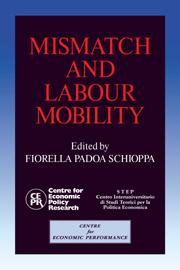Book contents
- Frontmatter
- Contents
- List of figures
- List of tables
- Preface
- Acknowledgements
- List of conference participants
- 1 A cross-country comparison of sectoral mismatch in the 1980s
- 2 Mismatch: a framework for thought
- Discussion
- 3 Match and mismatch on the German labour market
- Discussion
- 4 Mismatch in Japan
- Discussion
- 5 Mismatch and internal migration in Spain, 1962–86
- Discussion
- 6 Regional inequalities, migration and mismatch in Italy, 1960–86
- Discussion
- 7 Skill shortages and structural unemployment in Britain: a (mis)matching approach
- Discussion
- 8 Labour market tightness and the mismatch between demand and supply of less-educated young men in the United States in the 1980s
- Discussion
- 9 Skill mismatch, training systems and equilibrium unemployment: a comparative institutional analysis
- Discussion
- 10 Unemployment, vacancies and labour market programmes: Swedish evidence
- Discussion
- 11 Mismatch and labour mobility: some final remarks
- Index
7 - Skill shortages and structural unemployment in Britain: a (mis)matching approach
Published online by Cambridge University Press: 05 October 2010
- Frontmatter
- Contents
- List of figures
- List of tables
- Preface
- Acknowledgements
- List of conference participants
- 1 A cross-country comparison of sectoral mismatch in the 1980s
- 2 Mismatch: a framework for thought
- Discussion
- 3 Match and mismatch on the German labour market
- Discussion
- 4 Mismatch in Japan
- Discussion
- 5 Mismatch and internal migration in Spain, 1962–86
- Discussion
- 6 Regional inequalities, migration and mismatch in Italy, 1960–86
- Discussion
- 7 Skill shortages and structural unemployment in Britain: a (mis)matching approach
- Discussion
- 8 Labour market tightness and the mismatch between demand and supply of less-educated young men in the United States in the 1980s
- Discussion
- 9 Skill mismatch, training systems and equilibrium unemployment: a comparative institutional analysis
- Discussion
- 10 Unemployment, vacancies and labour market programmes: Swedish evidence
- Discussion
- 11 Mismatch and labour mobility: some final remarks
- Index
Summary
Some broad facts about the structure of British unemployment
Media discussion of British unemployment often focuses on the low level of training and vocational skills of the British workforce compared to that of Britain's main industrial competitors. In a world increasingly dominated by the use of robots and other electronic aids to production, traditional manual jobs are harder to come by. It is hardly surprising, so the argument goes, that 1980s' unemployment has been heavily concentrated amongst the unskilled and untrained, while those with computer skills and the like have been in heavy demand – there is, in other words, a growing mismatch between the supply of, and the demand for, different types of labour. Yet academic research on the nature of Britain's unemployment has generally failed to lend support to the idea that technological change has been a significant factor (for example, Layard and Nickell, 1986). Inadequate skills may have much to do with low productivity and low wages, but relatively little to do with high unemployment. Is the casual empiricism misguided, or has academic research missed the point? The purpose of this study is to have another look at the question, invoking microeconomic evidence.
Before plunging into detail, however, it is useful first to set the scene by describing some broad features of the structure of British unemployment in the years 1970–90. Table 7.1 begins by presenting data on the composition of unemployment at selected dates; this reveals marked divergences in unemployment rates by age, sex, region and occupation.
- Type
- Chapter
- Information
- Mismatch and Labour Mobility , pp. 325 - 353Publisher: Cambridge University PressPrint publication year: 1991
- 2
- Cited by



